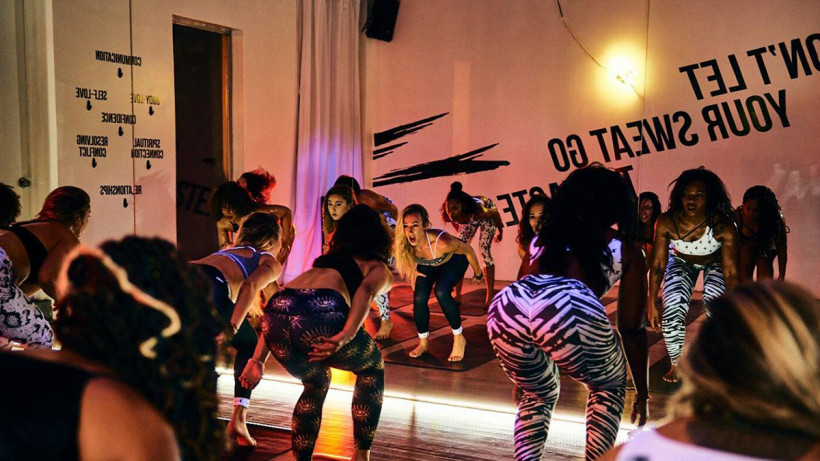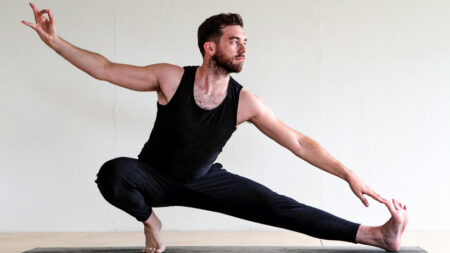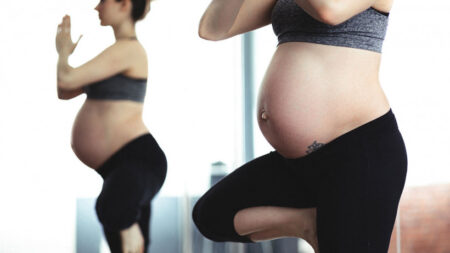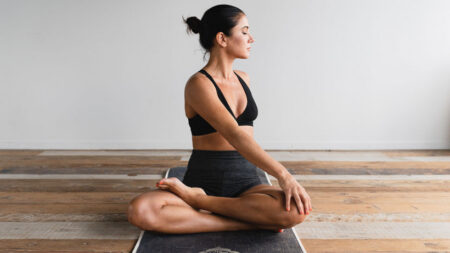A yogi’s guide to buti yoga - what is it, what are the benefits and why do women love it?
Pronounced “booty”, buti yoga combines plyometrics (jumping movements), intentional shaking, tribal dancing and power yoga for an explosive, cardio-intense practise. It feels a dance class, with a couple of traditional yoga moves chucked in along the way.
For most people, going to a yoga class means an hour of deep breathing, sun salutations and leaving with a general sense calm. For buti yoga fanatics, this couldn’t be further from the truth. A high-intensity workout, at first, a buti yoga class feels more like dancing to your favourite song in your underwear than practising yoga.
But where did buti come from and what are the benefits of this relatively new form of yoga?
What is buti yoga?
Buti is an Indian-Moroccan word that means ‘a cure to something that’s been hidden away or kept secret’. Founded by personal development coach and celebrity trainer Bizzie Gold in 2010, Gold said buti yoga was her way of using movement to heal her body.
In a YouTube interview, Gold says how she “sees herself as someone who was listening to a very important message of the evolution of yoga and how badly our bodies were in need of it.”
Today, there’s over 1,300 qualified buti yoga instructors all over the globe and with celebrity fans including Jennifer Love-Hewitt, this new form of yoga has gained a somewhat cult following.
Buti yoga master trainer and qualified personal trainer, Sara Fakih explained: “The difference with a buti class to say, a vinyasa, is that there is a lot more creative flow, plus there are elements of strength and conditioning, cardio bursts and tribal and primal movement within the flows.
“For example; we could link four to five asanas (poses) and then start to do reverse burpees or take you to goddess and start moving in a very primal way. There is a lot of pulsating through the class which really strengthens the muscles stabilising you in each asana.”
What is buti yoga supposed to do?
The practice of buti yoga is designed to strip everything away, and transform you from within. It’s not taught as a class to help you lose weight, but it tones and strengthens muscles through cardio bursts during the 50-60 minute class.
Each buti yoga class is focused around core engagement, making you strong and flexible and after a few weeks of regular practise, you’ll start to see a difference in your body (just look at Gold’s six pack if you don’t believe us). Like other forms of yoga, buti works to strengthen and lengthen the muscles and help protect the body from injury.
What are the principles of buti yoga?
Buti is founded on what Gold has named the Spinal Structure Technique (SST). Gold recognised that most of the exercise we do moves our body on a linear plane, treating the body as if it were a square and overworking the same muscle groups. The exercises in buti yoga aim to spiral the body, working into core stabiliser muscles we often ignore.
Fakih claims that “spiralling can be lined to Kundalini energy – a concentration of feminine energy lying dormant at the base of your spine.” Buti yoga sequences aim to engage deeper parts of the core, including the pelvic floor, which can help support the pelvic organs.
Buti is also a popular choice for women after childbirth, as the core stabilising exercises can help women with Diastasis recti – the abdominal separation women often experience during pregnancy. It’s important to note, women who have recently given birth should always check with their GP or midwife before doing any form of exercise.
Buti yoga: Tribal dance
Whilst you don’t need to be able to dance before going to a buti yoga class, tribal dance shapes a lot of the moves and sequences you’ll practise on the mat. Fakih warns beginner’s not to be put off by this however, but to remember “it is just movement”.
The tribal dance is important to buti’s “healing from within” message. “When you look back at any ancient healing ceremonies through shamanic traditions, there is a lot of dance movement. It helps to break our own barriers and set us free. It is also extremely grounding, especially to move like that barefoot” Fakih explains.
Unlike a formal dance class, in buti yoga, there isn’t any choreography or counting to eight – it’s about moving your body freely and releasing stored emotions.
Buti yoga: Plyometrics
Plyometric exercises are fast and explosive and involve a jumping movements that contract, then immediately lengthen muscles. The goal of plyometric training is to strengthen your muscles by improving their ability to contract and produce force more quickly.
The plyometric elements of a buti yoga class are what make it more cardio-intense than most other forms of yoga. These explosive movements will raise your heart rate, meaning you’ll burn more calories and increase your resting metabolic rate, whilst strengthening your muscles.
Buti yoga: Poses
Like all yoga practises, in a buti yoga class you follow your breath. Traditional yoga poses are incorporated into the practise, and the focus on coming back to your breath and taking your time is just as important here as it is in a yin class. “It’s your own practice and your own journey. Your mat is your space, so you can always take a child’s pose to rest and come back your breath. It’s still a yoga practise and your breath has to come first”, Fakih adds.
How important is the music to a buti yoga class?
Another important element of the class is the music it’s based around. “Music guides our classes like an internal GPS; it has helped with my creativity on and off the mat hugely and this is why this practice is so powerful”, explains Fakih.
The beat of the music helps you to focus on your body, whilst incorporating the shaking vibrations of some of the movements. The playlist of the class is carefully crafted to help yogi’s release what’s holding them back and cure themselves from within.
Is buti yoga just for women, or can men try it too?
Far more than just a workout, buti yoga is seen as a female movement. Defined in Yogapedia as a “female empowerment workout”, a lot of the energy comes from the tribe of women in the room.
Fakih explains “buti yoga is all about connection; I’ve never taught a class where I’ve not seen people connect with each other! We don’t compete as there is no ego; we have fun, we sweat, breathe, flow, connect back to ourselves, let go and work towards loving ourselves.”
Watch videos of a buti yoga class and you’ll see women of all body shapes in a sports bra and yoga shorts – there’s no judgement or embarrassment, but a real sense of sisterhood. The intention behind the outfit is to be able to see the core as you work into it, and instructors often say even the most self-conscious yogis are embracing buti’s body positive message after their first class.
But does this mean that buti yoga is just for women? Although buti started as a female-only workout, there are now more men turning up to classes.
“We are now realising that men need this type of movement just as much as women do. It’s about supporting and nursing the divine balance between masculine and feminine and recognising we both have both energies in each of us” Fakih clarifies.
What are buti sculpt and buti band classes?
Since the inception of buti yoga, Bizzie Gold has continued to evolve the practise and has designed buti sculpt and buti band. Both buti sculpt and buti band classes are 30 minutes long, and are more intense than a normal buti yoga class. Using a High Intensity Interval Training (HIIT) format, in each class you move through four rounds, each consisting of five high-low intervals.
The high-intensity interval consists of either dance-cardio or resistance band exercises to target muscles, make you sweat, and burn fat. The low-intensity part of each set will involve holding a static yoga pose.
Where can I try buti?
As a relatively new form of yoga, you probably won’t find a buti yoga class in your local town hall, but there are more popping up all over the place. The practise is most popular in the US and Canada, where yogi’s can use the online class finder on the buti yoga website to find their nearest studio.
Buti Yoga in the US
The US is by far the place where buti yoga is most prevalent with a number of studios hosting classes every week.
One of the most popular locations in New York is CompleteBody, a studio located in Manhattan’s Financial District. Sessions are held every Tuesday at 12pm and can be booked via the studio itself or using ClassPass.
If you’re over in LA you can head over to a buti yoga class at Studio U. The classes run at various times throughout the week lasting for 55 minutes and can be booked via the studio or through ClassPass. Classes cost $35.
Buti Yoga In the UK
In London there aren’t many locations to try buti yoga, however, Gymbox, one of London’s most popular gym chains hosts classes at a selection of its gyms. The session covers a fusion of power yoga, tribal dance and plyometrics and has received a fair amount of positive praise from those that have taken part in the class.
You will however need to be a member of Gymbox to take part and monthly membership can cost upwards of £100.
Buti yoga online
Buti also has a huge amount of online subscribers, who tune in to take part in what buti calls their online “tones” (classes) from their home. “Obviously a live class is very different because the energy is alive” Farkih, who teaches both in London and online explains, “many cannot get to a live class so there are now hundreds of tones online. It’s a great way to be able to keep a home practise.”
Main image credit: Buti Yoga – Facebook





